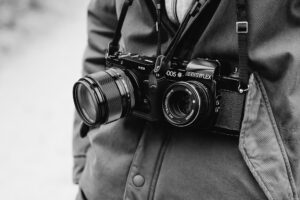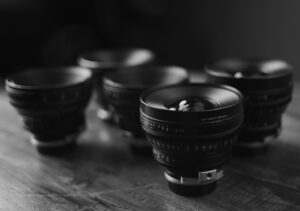When you’re just starting out in photography or video, you’ll quickly come across technical terms like RAW format, Log video, and 10-bit color. These formats aren’t just buzzwords, they directly impact the flexibility and quality of your images and footage, especially when editing. In this post, we’ll break down what each of these terms means, why they matter, and whether you actually need them right now as a beginner.
TL;DR
- RAW format in photography captures all image data, allowing for more flexibility in post-processing (exposure, white balance, etc.).
- JPEGs are compressed and processed in-camera, making them smaller but less editable.
- RAW video gives editors maximum control, capturing unprocessed image data directly from the sensor.
- Log video flattens colors and contrast to preserve dynamic range for color grading.
- Bit depth (8-bit, 10-bit, 12-bit) affects how smooth color gradients look, especially in skies, shadows, and color transitions.
- Beginners don’t always need RAW or Log, but understanding them early helps prepare you for higher-end work later.
- Use RAW for photos if you plan to edit. Use Log or 10-bit if you’re serious about video color grading.
This post is just one part of my “Camera Buying Guide“, which you can download as a pdf file right now.
What Is RAW Format in Photography (And Why It Matters)
Most people are familiar with JPEG (.jpg) image files. But if you’re serious about photography, you’ll want a camera that supports RAW format.
RAW files store uncompressed image data straight from the camera sensor, giving you maximum control in editing; something JPEGs can’t match.
For example:
- In JPEG, white balance is baked in and hard to adjust later without damaging image quality.
- In RAW, you can adjust white balance, exposure, shadows, and highlights freely: ideal for challenging lighting.
- RAW files also retain more detail, making them better for lens correction, like fixing distortion caused by wide-angle lenses.
If you’re even slightly interested in improving your photography skills, make sure the camera you choose supports RAW. All DSLRs and mirrorless cameras do. Some higher-end compact and action cameras do as well.
Each camera manufacturer has its own proprietary RAW format. While they all serve the same purpose -capturing unprocessed sensor data- the file extensions and features can vary slightly:
- Canon:
.CR2(older models),.CR3(newer models) - Nikon:
.NEF - Sony:
.ARW - Fujifilm:
.RAF - Panasonic / Leica / Olympus:
.RW2(Panasonic),.ORF(Olympus),.RWL(Leica) - Pentax:
.PEF,.DNG - Apple:
.DNG(ProRAW on iPhone) - Adobe DNG:
.DNG(open standard, supported by many brands and software)
Note: Some cameras let you choose between compressed, lossless compressed, and uncompressed RAW. Lossless compressed is often the best balance between file size and quality.
RAW and Log Video Explained for Beginners
Just like in photography, shooting in RAW format for video means capturing the most unprocessed, uncompressed data straight from the camera sensor. But since video files are much larger and more complex, there are additional formats and terms you need to know, especially if you’re serious about color grading and professional-looking footage.
What Is Log Video? Pros, Cons, and Use Cases
Log (short for logarithmic) profiles flatten the image, lowering contrast and saturation. At first glance, Log footage looks washed-out and dull, but that’s intentional. It’s designed to preserve more highlight and shadow detail, giving you far more flexibility in post-production.
Common Log profiles include:
- S-Log (Sony)
- C-Log (Canon)
- V-Log (Panasonic)
- F-Log (Fujifilm)
- N-Log (Nikon)
You should shoot in Log if:
- You plan to color grade seriously
- You want cinematic dynamic range
- You’re working in mixed lighting conditions
Just keep in mind: Log footage requires editing. You’ll need to apply a LUT (Look-Up Table) or do manual grading to get a final look.
What Is RAW Video? Ultimate Flexibility for Editing
RAW video goes one step further than Log. Instead of compressing or processing the data at all, it captures pure sensor data, preserving maximum dynamic range, color detail, and tonal information.
But there’s a catch:
- File sizes are massive
- It requires high-speed memory cards and external recorders (in many cases)
- You need powerful hardware to edit RAW smoothly
Popular RAW formats include:
- ProRes RAW
- Blackmagic RAW (BRAW)
- Canon RAW Light
- ARRI RAW
- Redcode RAW
Shooting in RAW is ideal for:
- High-end commercial work
- Visual effects (VFX)
- Heavy color grading workflows
If you’re shooting passion projects, client videos, or social content with a strong emphasis on post-production, RAW can take your footage to the next level; if your camera supports it.
RAW vs. Log Footage: What’s the Difference?
Both RAW and Log video formats are designed to preserve as much image information as possible, but they do it in different ways, and serve slightly different purposes.
- RAW video captures unprocessed sensor data. It’s like a digital film negative. Nothing is baked in: not white balance, contrast, sharpness, or color profile. This gives you maximum flexibility in post-production but also results in much larger file sizes and requires more powerful hardware and software to edit.
- Log video, on the other hand, is still compressed and processed by the camera, but it uses a flat color profile to retain more dynamic range and highlight detail. You don’t get the same editing headroom as RAW, but it’s far more manageable in terms of file size and workflow, making it a favorite for solo creators and YouTubers.
In short:
- RAW is like a digital raw ingredient, ideal for high-end productions and commercial work where image quality is critical.
- Log is more like a ready-to-cook meal base, flatter than normal footage, but easier to store and faster to work with.
If you’re just starting out, Log will give you a solid introduction to color grading and dynamic range without overwhelming your editing setup. But as you grow, you may find yourself reaching for RAW when every detail matters. range without overwhelming your editing setup. But as you grow, you may find yourself reaching for RAW when every detail matters.
Bit Depth in Video: What 8-Bit, 10-Bit, and 12-Bit Really Mean
This refers to the color depth of your footage, or how many shades of color the camera can capture.
- 8-bit video = 256 shades per RGB channel = ~16 million colors
- 10-bit video = 1,024 shades per channel = over 1 billion colors
- 12-bit video = 4,096 shades per channel = 68 billion+ colors
Why it matters:
- Better gradients and smoother skin tones
- Less banding in skies and low-light areas
- More flexibility when color grading
If you plan to shoot in Log or RAW, aim for a camera that supports at least 10-bit 4:2:2 recording, either internally or via HDMI output. That’s a sweet spot between quality and practicality for solo creators.
Do You Need High Bit Depth as a Beginner?
Not always. If you’re just starting out, don’t get caught up in buzzwords. Many beginner creators shoot 8-bit, Rec.709 video and get beautiful results, especially with good lighting and framing.
But if you’re serious about learning cinematic video or offering professional services, it’s worth understanding these formats and eventually upgrading your gear.
To learn about other camera specs, read our camera specs explained post.
Reminder: This post is just one part of my “Camera Buying Guide“, which you can download as a pdf file right now.
Last Words
RAW and Log formats aren’t just for professionals, they’re tools that unlock creative possibilities when you’re ready to grow. If you’re a beginner, don’t feel pressured to use these right away. But understanding what they are (and how they impact quality) helps you make smarter gear decisions and prepare for more advanced projects. Whether you’re shooting photos or video, the more control you have over your image, the more powerful your storytelling can become.
FAQ
What’s the advantage of shooting in RAW for photos?
RAW files retain all image data, allowing you to adjust exposure, white balance, and recover detail in post without image degradation.
Should I use Log or RAW formats for video?
Use Log for easier, smaller-file color grading. Choose RAW if you want maximum dynamic range and flexibility, but be prepared for large files and heavier editing needs.
What does “10-bit” or “12-bit” mean in video?
It refers to color depth, higher bit-depths (10/12 bit) provide smoother gradients and better grading potential, useful when shooting Log or RAW.




